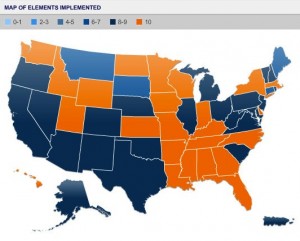10 Things States Need To Collect Good Data On Students

Data Quality Campaign
A map prepared by the Data Quality Campaign. The states in gold have data-collection practices which comprise all 10 "Essential Elements" of collecting solid education data. Click on the map for an interactive version at the organization's website.
For this first time this year, a national organization that advises states on how to track students’ education has listed Indiana as having all 10 “Essential Elements” of good education data.
When the Data Quality Campaign started its effort in 2005, no state’s data collection policies comprised all 10 elements — and Indiana’s only covered three. (Florida was the earliest to adopt all ten, for the record.)
The Data Quality Campaign has wide support across the ideological spectrum, partnering with 90 different organizations across the education community — from teacher unions like the American Federation of Teachers, to think tanks like the Fordham Institute.
Here are the 10 things the Data Quality Campaign says states need to collect good data on students. (In parentheses, you can see how many states the DQC says has these elements.)
- Give each student a unique ID number that stays with them through their school career (50 states)
- Collect accurate headcounts on who’s enrolled — demographic, socioeconomic, and program participation information (50 states)
- Build a database that shows students exam scores from year to year (50 states)
- If a student wasn’t tested because he or she is an ELL or special education student, collect information on why he or she wasn’t tested (48 states)
- Give each teacher a unique ID to match their skills and certifications to figure out how to match teachers’ skills with a student’s needs (33 states)
- Figure out what courses each student takes — does making him or her take more rigorous courses make them better students? (35 states)
- Collect students’ test scores on AP, IB, SAT, SAT II, and ACT tests (45 states)
- Determine how many students are graduating or dropping out of school (50 states)
- Match records from elementary and secondary education with college or post-secondary education records (41 states)
- Create a system to audit districts who give inaccurate or unreliable data (50 states)